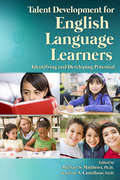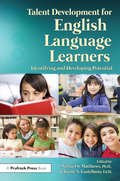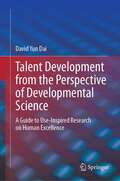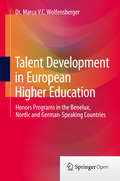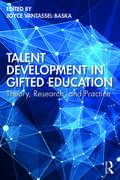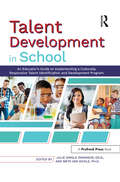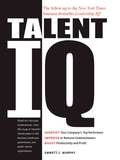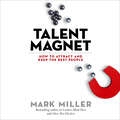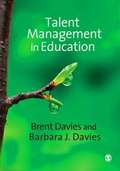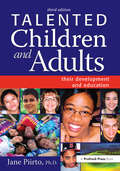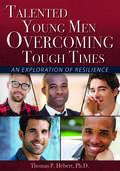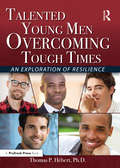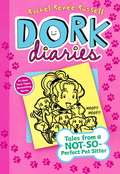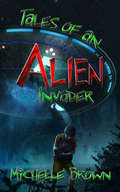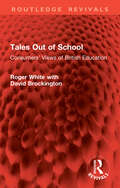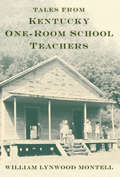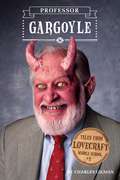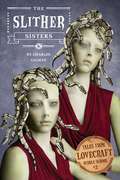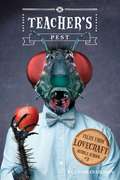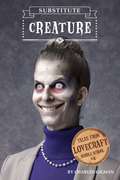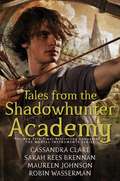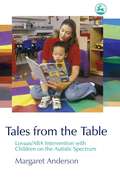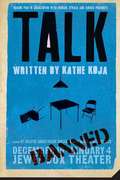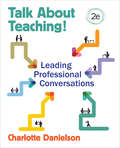- Table View
- List View
Talent Development for English Language Learners
by Michael Matthews Jaime CastellanoTalent Development for English Language Learners offers concrete guidance to teachers, schools, and administrators seeking to maximize the potential of all of their students. Each chapter will focus thematically on an issue relevant to developing the talents and potential of gifted English language learners (ELLs) in inclusive educational settings. Examples are provided of how schools or educators might conventionally conceptualize and handle the issues related to ELLs and what the concerns or unintended negative outcomes are for gifted ELLs. The authors focus on what an "ideal" response might be from the lens of both the gifted education and the language education field, and how collaborative efforts across these perspectives yield effective interventions in schools and related educational settings for students who are both English language learners and highly academically able.
Talent Development for English Language Learners: Identifying and Developing Potential
by Michael S. Matthews Jaime A. CastellanoTalent Development for English Language Learners offers concrete guidance to teachers, schools, and administrators seeking to maximize the potential of all of their students. Each chapter will focus thematically on an issue relevant to developing the talents and potential of gifted English language learners (ELLs) in inclusive educational settings. Examples of how schools or educators might conventionally conceptualize and handle the issues related to ELLs and what the concerns or unintended negative outcomes are for gifted ELLs are provided. The authors focus on what an “ideal” response might be from the lens of both the gifted education and the language education field, and how collaborative efforts across these perspectives yield effective interventions in schools and related educational settings for students who are both English language learners and highly academically able.
Talent Development from the Perspective of Developmental Science: A Guide to Use-Inspired Research on Human Excellence
by David Yun DaiThis is a guide book for the field of studies on talent development and human excellence. It reviews the existing literature on the topic and helps map out a taxonomy of research with detailed description of purposes and methods of specific kinds of research on the topic and how each of them contributes to the larger scheme of understanding, identifying, and promoting talent development and human excellence for the vitality of society as well as the fulfillment of individuals. It fits with the new trend of developmental science that promotes use-inspired research and seeks a deep understanding of developmental diversity and aims to promote positive development, including human excellence. It is intended to guide researchers and graduate students in this emerging field of studies from a broad developmental science perspective.
Talent Development in European Higher Education
by Dr Marca V. C. WolfensbergerThis book examines the much-debated question of how to unleash the potential of young people with promising intellectual abilities and motivation. It looks at the increasingly important topic of excellence in education, and the shift in focus towards the provision of programs to support talented students in higher education. It provides a systematic overview of programs for talented students at northern European higher education institutions (HEIs). Starting in the Netherlands, where nearly all HEIs have developed honors programs over the past two decades, the book explores three clusters of countries: the Benelux, the Nordic and the German-speaking countries. For each of these countries, it discusses the local culture towards excellence, the structure of the education system, and the presence of honors programs. In total, the book reviews the special talent provisions for nearly four million students at 303 higher education institutions in eleven countries. In addition, it offers an analysis of the reasons to develop such programs, a look into the future of honors education and a practical list of suggestions for further research. The Sirius Program assigned Marca Wolfensberger to carry out this research.
Talent Development in Gifted Education: Theory, Research, and Practice
by Joyce VanTassel-BaskaThis volume brings together experts in gifted education to explore critical perspectives in talent development across the lifespan, guiding readers toward a deeper understanding of advanced learners and their education. Chapters in the first section delve into the foundational theory, research, and models of practice underpinning gifted education and talent development, while the second section examines the practical applications of talent development in assessment, programming, and ongoing research. The book concludes with an exploration of talent throughout the lifespan, featuring detailed case vignettes to illustrate development across diverse fields of practice. Ideal for researchers as well as students of gifted education and creativity studies, this comprehensive handbook challenges readers to interrogate what they think they know about giftedness and talent development.
Talent Development in School: An Educator's Guide to Implementing a Culturally Responsive Talent Identification and Development Program
by Julie Dingle Swanson Meta Van SickleTalent Development in School helps educators utilize research-based curriculum and strategies to implement talent development in the classroom. This practical guide:Focuses on a talent development model that is centered on teacher learning.Highlights talent development's impact on culturally, linguistically, and economically diverse learners.Details how to apply the talent development model in one's school or district and opening access and opportunity to all students.Reviews current theories, concepts, and research on talent development in the field of gifted education.Is perfect for teachers, coordinators, and administrators.Talent Development in School features techniques for culturally responsive teaching and considerations for how psychosocial skills and noncognitive influences on learning—such as motivation, grit, resiliency, and growth mindset—affect talent development. Written by experts in the field, this book will become a go-to for professional learning and development.
Talent IQ: Identify Your Company's Top Performers, Improve or Remove Underachievers, Boost Productivity and Profit
by Emmett C MurphyTalent is a company's most valuable resource. Today, more than ever, the fate of your organization depends on your ability to recruit, retain, and, when necessary, replace talent. By the same token, talent management determines the success or failure of your own career. Talent IQ teaches you how to make the most of your own, your team's, and your organization's talent - from junior support staff to C-level executives. Based on an extensive ten-year study of best practices among 100,000 TalentLeaders in virtually every type of organizational setting, Talent IQ identifies the concepts, skills, and tools any manager and organization can use to boost their Talent IQ and build a culture of achievement.
Talent Magnet: How to Attract and Keep the Best People
by Mark MillerThe Wall Street Journal-bestselling author &“provides a pragmatic approach to the art of attracting and retaining top talent . . . A must-read for leaders&” (Candice L. Saunders, President and CEO, WellStar Health System). What Does Top Talent Really Want? More than vision, strategy, creativity, marketing, finance, or even technology, it is ultimately people that determine organizational success. That&’s why virtually every organization wants more top talent. But do you know what they&’re looking for? It might not be what you think! Talent Magnet will show you how to attract and keep great people. &“The war for talent is on, and many good leaders and organizations are really struggling. Talent Magnet presents a terrific approach that is both insightful and actionable—born out of firsthand research and told through a readable and relatable story. I read it straight through.&” —Stephen M. R. Covey, New York Times- and #1 Wall Street Journal-bestselling author of The Speed of Trust &“People drive your success more than anything else, and Mark Miller shows us how to attract the best of them to your company.&” —Randy Street, New York Times-bestselling coauthor of Who &“Great people are going to work somewhere—why not for you? Talent Magnet will show you how to attract the people every organization wants. Read it to take your team and organization to the next level.&” —Jon Gordon, Wall Street Journal-bestselling author of The Energy Bus
Talent Management in Education
by Brent Davies Dr Barbara J DaviesTalent management is a critical factor in developing successful organizations. There is a need for organisations to develop 'talent pools' of great staff for the future direction and leadership of our schools. This book explains the key concepts and provides frameworks for leaders to apply ideas of talent management in their organizations. The authors focus on talent management and how this contributes to other strategic objectives, such as building a high performance learning environment and building leadership in depth in the school. In showing how to develop talented individuals for roles and responsibilities in new configurations of schools and leadership, the authors focus on: - Defining who are the talented individuals in your school - Developing talent individuals & leaders in your school - Building a talent culture in the school. This book is important for schools which are facing the challenge of developing innovative and imaginative leaders to meet the needs of school transformation. It is useful for school leaders and managers in educational organisations, such as Head teachers and senior leaders, aspiring middle and senior leader programmes and school business managers both in the UK and around the world. Brent Davies is Professor of Leadership Development at the University of Hull. Barbara Davies is a researcher in the Business School at the University of Hull.
Talented Children and Adults: Their Development and Education
by Jane PiirtoThis third edition of the widely popular Talented Children and Adults: Their Development and Education has been revised to include the most up-to-date information on talent development. Written by a nationally recognized author in the field of gifted education, this textbook explores the factors that encourage talent development from birth through adulthood, with specific chapters focusing on children from birth to age 2, elementary and middle school students, high school and college students, and adults. Talented Children and Adults includes information for identifying talented students, developing programs for these students, identifying creativity, and creating appropriate curricula. The book also addresses counseling and guidance for talented students, as well as underserved populations.Each chapter begins with a vignette, and case studies from students and educators in the field are included at the end of each chapter. This book is a must-read for anyone who works with talented children and adults.Educational Resource
Talented Young Men Overcoming Tough Times: An Exploration of Resilience
by Thomas HebertTalented Young Men Overcoming Tough Times features the life stories of five gifted, high-achieving young men who overcame serious adversity in their lives. Their stories, captured through qualitative interviews, help us to better understand the factors that shaped their resilience and enabled them to overcome difficult challenges, including homelessness, poverty, bullying, dysfunctional families, and abuse. The five young men succeeded in overcoming their difficult circumstances in adolescence and met strong success in higher education, obtaining advanced graduate degrees and moving on to productive professional careers. The author presents the five life stories by dedicating an individual chapter to each young man featured in the book and concludes by synthesizing the consistent themes that are woven throughout the five inspirational life stories.
Talented Young Men Overcoming Tough Times: An Exploration of Resilience
by Thomas P. HébertTalented Young Men Overcoming Tough Times features the life stories of five gifted, high-achieving young men who overcame serious adversity in their lives. Their stories, captured through qualitative interviews, help us to better understand the factors that shaped their resilience and enabled them to overcome difficult challenges, including learning disabilities, homelessness, poverty, bullying, dysfunctional families, and abuse. The five young men succeeded in overcoming their difficult circumstances in adolescence and met strong success in higher education, obtaining advanced graduate degrees and moving on to productive professional careers. The author presents the five life stories by dedicating an individual chapter to each young man featured in the book and concludes by synthesizing the consistent themes that are woven throughout the five inspirational life stories.
Tales From A Not-So-Perfect Pet Sitter (Dork Diaries #10)
by Rachel Renée RussellNikki and her friends Brandon, Chloe, and Zoey are teamed up on an important mission in the tenth book in the #1 New York Times bestselling Dork Diaries series. Nikki has to hide seven ADORKABLE puppies from two parents, one nosy little sister, an entire middle school, and…one mean girl out for revenge, MacKenzie Hollister. If anyone can do it, it’s Nikki…but not without some hilarious challenges along the way!
Tales Of An Alien Invader
by Michelle Brown David M. F. Powers Zefanya MaegaMeet Felix Winters, an eleven-year-old alien sent on his first scouting mission to Earth. His assignment is simple: blend in, observe his surroundings, and ultimately decide the fate of humanity. But blending in is harder than he imagined, as, upon enrolling in a local middle school, he becomes the target of a trio of boys led by Curtis Jenkins, a bully with a sick sense of humor. It's only thanks to a surprising newfound passion for baseball and the friendship of two fellow outcasts that Felix feels like he might have a chance. As he immerses himself further in the daily life of a preteen--and the ups, the downs, and the struggle to fit in that comes with it--he realizes something troubling, something that was not a part of the plan. He may be becoming a little too human. His mission becomes even more complicated when he stumbles upon a startling discovery that forces him to face the facts: Felix Winters doesn't have everyone fooled.
Tales Out of School: Consumers' Views of British Education (Routledge Revivals)
by Roger White David BrockingtonOriginally published in 1983, reissued here with a new preface, Tales Out of School presents the experience of seventy young people from different parts of the country, most of whom left school at sixteen and are now either in work, unemployed or in the twilight world of the Youth Opportunities Programme. Through a series of interviews they reflect upon their eleven years of compulsory schooling and the preparation it gave for the world of work, offer their comments and criticize the school institution and processes. Many of them have experienced long periods of unemployment, and their perceptions of the relationship between school and adult life are both revealing and thought-provoking.The second part of the book initiates a dialogue between pupils and the Establishment by presenting responses to the young people’s comments from well-known adults who were at the time specialists in particular educational fields and who were in a position to have some influence on practice and policy. This unique juxtaposition of the views of both ‘consumers’ and ‘enablers’ provides the basis of a valuable and exciting debate. Today it can be read in its historical context.
Tales from Kentucky One-Room School Teachers
by William Lynwood MontellThis colorful collection of stories celebrates a fascinating aspect of Kentucky&’s cultural heritage in &“a fascinating look back at a bygone era&” (Kentucky Monthly). In an educational era defined by large school campuses and overcrowded classrooms, it is easy to overlook the era of one-room schools, when teachers filled every role, including janitor, and provided a family-like atmosphere in which children also learned from one another. In Tales from Kentucky One-Room School Teachers, oral historian William Lynwood Montell reclaims an important part of Kentucky's social, cultural, and educational heritage, assembling a fascinating collection of schoolroom stories. The firsthand narratives and anecdotes in this collection cover topics such as teacher-student relationships, day-to-day activities, lunchtime foods, students' personal relationships, and, of course, the challenges of teaching in a one-room school. Montell includes tales about fund-raising pie suppers, pranks, outrageous student behavior—such as the quiet little boy whose first &“sharing&” involved profanity—and many other topics. Montell even includes some of his own memories from his days as a pupil in a one-room school.
Tales from Lovecraft Middle School #1: Professor Gargoyle (Tales from Lovecraft Middle School #1)
by Charles Gilman"Two-headed monsters, giant tentacles, angry demons - Lovecraft Middle School is great creepy fun!" -Ransom Riggs, author of Miss Peregrine's Home for Peculiar Children Strange things are happening at Lovecraft Middle School. Rats are leaping from lockers. Students are disappearing. The school library is a labyrinth of secret corridors. And the science teacher is acting very peculiar - in fact, he just might be a monster-in-disguise. Twelve-year-old Robert Arthur knew that seventh grade was going to be weird, but this is ridiculous! Professor Gargoyle (Volume I in the Tales from Lovecraft Middle School series) is full of bizarre beasts, strange mysteries, and nonstop adventure. It's perfect for readers ages 10 and up. Best of all, the cover features a state-of-the-art "morphing" photo portrait - so you can personally witness the professor transforming into a monster. You won't believe your eyes! "Gilman's debut and series kick-off is great fun for fans of light horror. The changing image on the cover will snag interest, and the spookily realistic black-and-white illustrations throughout complete this slick, scary, funny package. [There are] delectable hints of age-appropriate, Lovecraftian Otherness...with none of the purple prose." -Kirkus ReviewsFrom the Hardcover edition.
Tales from Lovecraft Middle School #2: The Slither Sisters (Tales from Lovecraft Middle School #2)
by Charles Gilman"Two-headed monsters, giant tentacles, angry demons - Lovecraft Middle School is great creepy fun!" -Ransom Riggs, author of Miss Peregrine's Home for Peculiar Children This second novel in the Tales from Lovecraft Middle School series begins right where Professor Gargoyle ended. Seventh-grader Robert Arthur has discovered that two of his classmates are actually sinister snake-women in disguise. Even worse, his new middle school is full of "gates" to a terrifying alternate dimension - a haunted mansion full of strange spirits and monstrous beasts. For Robert to protect his teachers and classmates, he'll need to return to this haunted dimension with his best friends Glenn and Karina. Can they uncover the secrets of Lovecraft Middle School before it's too late? The Slither Sisters features more bizarre beasts, more strange mysteries, and more adventure. It's perfect for readers ages 10 and up. Best of all, the cover features a state-of-the-art "morphing" photo portrait - so you can personally witness the sisters transforming into their slithering alter egos. You won't believe your eyes!
Tales from Lovecraft Middle School #3: Teacher's Pest (Tales from Lovecraft Middle School #3)
by Charles Gilman"Two-headed monsters, giant tentacles, angry demons--Lovecraft Middle School is great creepy fun!" --Ransom Riggs, author of Miss Peregrine's Home for Peculiar Children DON'T BE FOOLED by his friendly smile, his perfect manners, or his shiny red apple. Student council president Howard Mergler is actually a sinister bug-monster in disguise--and he's summoning swarms of roaches, wasps, fleas, and head lice into the corridors of Lovecraft Middle School! Twelve-year-old Robert Arthur is the only student who can stop him--but he'll need help from his best friends: the school bully, the school ghost, and an extremely courageous two-headed rat. This third novel in the Lovecraft Middle School series begins right where Professor Gargoyle and The Slither Sisters ended--with more action, more adventure, and more outrageous monsters!
Tales from Lovecraft Middle School #4: Substitute Creature (Tales from Lovecraft Middle School #4)
by Charles GilmanWhen a giant nor'easter dumps a blanket of snow on the village of Dunwich, Massachussetts, Robert Arthur and his friends find themselves marooned inside Lovecraft Middle School. The kids have no choice but to spend the night--while snacking on cafeteria food, sleeping on classroom floors, and facing off against a mysterious substitute teacher who may have a sinister secret. The latest adventure in the Lovecraft Middle School series features more adventures, more outrageous monsters, and another terrifying lenticular cover!
Tales from the Shadowhunter Academy: The Bane Chronicles; Tales From The Shadowhunter Academy; Ghosts Of The Shadow Market (Tales from the Shadowhunter Academy)
by Maureen Johnson Robin Wasserman Cassandra Clare Sarah Rees BrennanThe New York Times and USA TODAY bestselling collection of short stories chronicling the adventures of Simon Lewis as he trains to become a Shadowhunter is now available in print with ten brand-new comic illustrations! <p><p> Simon Lewis has been a human and a vampire, and now he is becoming a Shadowhunter. The events of City of Heavenly Fire left him stripped of his memories, and Simon isn’t sure who he is anymore. So when the Shadowhunter Academy reopens, Simon throws himself into this new world of demon-hunting, determined to find himself again. Whomever this new Simon might be. <p> But the Academy is a Shadowhunter institution, which means it has some problems. Like the fact that non-Shadowhunter students have to live in the basement. At least Simon’s trained in weaponry—even if it’s only from hours of playing D&D. <p> Join Simon on his journey to become a Shadowhunter, and learn about the Academy’s illustrious history along the way, through guest lecturers such as Jace Herondale, Tessa Gray, and Magnus Bane. Written by Cassandra Clare, Sarah Rees Brennan, Maureen Johnson, and Robin Wasserman, these moving and hilarious short stories are perfect for the fan who just can’t get enough of the Shadowhunters.
Tales from the Table: Lovaas/ABA Intervention with Children on the Autistic Spectrum
by Margaret AndersonTales from the Table is a practitioner's account of the successes and limitations of using Lovaas/ABA home education with five young boys on the autistic spectrum. The abilities and skills of these children before, during and after intervention are documented with a focus on the realities of undertaking Lovaas/ABA home education: the impact of a 35-hour learning week on both child and parents, changing tutors and issues of commitment to the approach. Each chapter includes a commentary on the programme from a different perspective, with the voices of parents, siblings and teachers providing the context to the individual children's learning processes. This book will help parents to make an informed decision about using Lovaas/ABA interventions and will give professionals and students practical insights and useful information on the approach.
Talk
by Kathe KojaKit Webster is hiding a secret. Carma, his best friend, has already figured it out, and pushes him to audition for the high school play, Talk. When he's cast as the male lead, he expects to escape his own life for a while and become a different person. What he gets instead is the role of a lifetime: Kit Webster. In the play, Kit's thrown together with Lindsay Walsh, the female lead and the school's teen queen. Lindsay, tired of the shallow and selfish boys from her usual circle of friends, sees something real in Kit -- and wants it. But Kit's attention is focused on Pablo, another boy in school. The play is controversial; the parents put pressure on the school to shut it down. And when Kit and Lindsay rally to save "Talk", they find themselves deep into a battle for the truth: onstage, and inside themselves.
Talk About Teaching!: Leading Professional Conversations
by Charlotte F. DanielsonImprove teaching practice through powerful professional conversations! Move beyond isolated teaching, passive observations, ineffective workshops and be the leader who engages staff and affirms the value of reflective and informal professional discussions. Read Talk About Teaching! to build a culture of understanding, respect, and empathy that breeds meaningful conversation and a powerful team of teachers who understand how students learn, what motivates them, and how to implement that research in the classroom. The second edition of this powerful book includes: A new chapter guiding conversations to align with CCSS and other standards Outlines for specific conversation skills needed to initiate and succeed Mental maps, sample topics, and conversation activities
Talk About Teaching!: Leading Professional Conversations
by Charlotte F. DanielsonImprove teaching practice through powerful professional conversations! Move beyond isolated teaching, passive observations, ineffective workshops and be the leader who engages staff and affirms the value of reflective and informal professional discussions. Read Talk About Teaching! to build a culture of understanding, respect, and empathy that breeds meaningful conversation and a powerful team of teachers who understand how students learn, what motivates them, and how to implement that research in the classroom. The second edition of this powerful book includes: A new chapter guiding conversations to align with CCSS and other standards Outlines for specific conversation skills needed to initiate and succeed Mental maps, sample topics, and conversation activities
